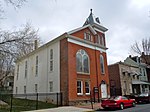Santander Arena

The Santander Arena (formerly known as the Sovereign Center) is a 7,160-seat multi-purpose arena, in Reading, Pennsylvania. It was built in 2001. The arena sits on the former site of the Astor Theater; one of several grand movie and theater palaces built in Reading in the early 20th century. Closed in 1975, the theater sat vacant for over two decades. In 1998, the Astor was demolished to make room for the Santander Arena. Early in construction, steps were taken to retain mementos of the Astor, including its ornate Art Deco chandelier and gates. These are on display and in use inside the arena corridors, allowing insight into the ambience of the former movie house. The Santander Arena is owned by the Berks County Convention Center Authority and managed by ASM Global. In 2000, the Rajah Shrine Theater was purchased, and after a thorough restoration and updating of the facilities was renamed the Sovereign Performing Arts Center. The Reading Eagle Theater is part of the complex. On October 13, 2013, the building's name was changed from Sovereign Center to Santander Arena.The arena is home to the Reading Royals ice hockey team in the ECHL as well as the Alvernia University Golden Wolves ice hockey team of the NCAA DIII. It was formerly home to the Reading Railers basketball team, the New York Majesty Lingerie Football League team, the Reading Rockets box lacrosse team, and the Reading Express indoor football team. The arena has hosted Jehovah's Witnesses District Conventions from 2005 to 2013 and will host the renamed Regional Conventions of Jehovah's Witnesses beginning in 2015.
Excerpt from the Wikipedia article Santander Arena (License: CC BY-SA 3.0, Authors, Images).Santander Arena
Penn Street, Reading
Geographical coordinates (GPS) Address Website External links Nearby Places Show on map
Geographical coordinates (GPS)
| Latitude | Longitude |
|---|---|
| N 40.334771 ° | E -75.923013 ° |
Address
Santander Arena
Penn Street 700
19602 Reading
Pennsylvania, United States
Open on Google Maps









